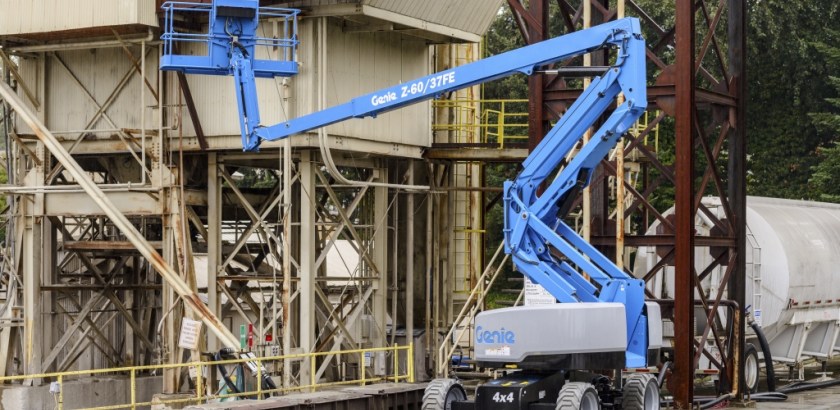Aerial Fleet Management: Considerations for 2WD vs. 4WD Boom Lifts
by Adam Hailey - Director of Global Design Engineering On Dec 14, 2017, 03:00 AM
Subscribe To Aerial Pros
Filter by tags
Aerial equipment is among the most rented machines in your rental store’s fleet. And, there is a good reason why — contractors’ needs change dramatically from one job to another, and to keep up with the needs of the contractors, rental yards should contain a broad range of sizes and features in aerial equipment.
Among the most important features in boom lifts is the ability to select between 2-wheel-drive (2WD) and 4-wheel-drive (4WD) units. Contractors don’t want to pay higher rental rates for 4WD if their job doesn’t require it. Likewise, rental stores want to limit the number of 4WD units to meet, but not exceed, the demand. So, how do you begin to evaluate your customers' needs and stock the appropriate boom lifts to maximize your rental return on invested capital (rROIC)?
Matching the Terrain
The first thing to understand is the working terrain of your customer’s jobsite. At Genie, we group working terrain into three classifications:
- Slab/Concrete — A smooth, level and flat surface like concrete or asphalt. A 2WD and 4WD boom lift will have almost identical performance in this type of condition, which means your customers may be able to save money by renting a 2WD unit.
- Improved Terrain — This classification includes hard or compacted smooth surfaces with gradual changes in slope. You’ll see this type of condition most often on jobs where a contractor is brought in to work before concrete or asphalt has been poured. In many situations, 2WD boom lifts are a suitable solution for these types of applications. However, if jobsite conditions have the potential to be impacted by changing weather conditions, or additional landscaping work being performed, you may want to advise your customers to upgrade to a 4WD unit.
- Rough Terrain — Rapidly changing slopes, slippery surfaces, dirt, mud and sand are all considered appropriate terrains for recommending 4WD boom lifts. The 4WD will provide your customers with the best overall performance to meet the demands of the working environment.
Features that affect performance
Likely, your customers’ jobsites do not fit perfectly into just one of the classifications listed above. Also, because you want to maximize your rROIC, this is where additional boom lift features and options make a difference for your customer and your bottom line.
Tires
 The standard tires for most smaller booms are designed specifically for indoor use, made from a solid rubber compound that is non-marking. When you move up in machine size, you’ll see more pneumatic or foam-filled tires with lug patterns for rough terrain. There is another option available that will not leave marks indoors while still providing traction in “improved terrain” conditions — most manufacturers, including Genie, offer optional industrial tires that look like car tires and are typically air or foam filled. These tires are non-marking so they can be used indoors, but the tread pattern does offer some traction in hard, dry conditions.
The standard tires for most smaller booms are designed specifically for indoor use, made from a solid rubber compound that is non-marking. When you move up in machine size, you’ll see more pneumatic or foam-filled tires with lug patterns for rough terrain. There is another option available that will not leave marks indoors while still providing traction in “improved terrain” conditions — most manufacturers, including Genie, offer optional industrial tires that look like car tires and are typically air or foam filled. These tires are non-marking so they can be used indoors, but the tread pattern does offer some traction in hard, dry conditions.
And, if you’re rental yard caters to contractors working in extreme conditions, you may want to consider offering your customers a boom lifts with tracks.
Oscillating Axle
When you want to maximize the performance of your aerial fleet without stocking multiple, similar-sized units, you should consider purchasing boom lifts equipped with active oscillating axles, a feature unique to Genie-branded booms and comes standard on all our 4WD machines. The active oscillation provides operators the confidence they need when working on unimproved terrain by keeping all four wheels on the ground. A 4WD boom with oscillating axles will even improve the drive performance in extreme ground conditions.
Matching the right machine for the working terrain improves performance and efficiency. Manufacturers like Genie are developing products to help bridge the gap between working terrain and applications.
Related Posts

Up Around and Over – Genie Boom Lifts
Genie® articulating and telescopic boom lifts give operators the reach and reliable performance they need to get aerial projects done.
Continue Reading

What is Dual Parallelogram Linkage on Articulating Booms?
From painting and power washing to more complex tasks, the ability to follow a wall is an important feature for many articulating boom applications.
Continue Reading

Using Telematics to Manage Your Fleet
No matter what size of aerial equipment fleet you have — from 1 to 100 machines — equipment management is something you do every day.
Continue Reading


